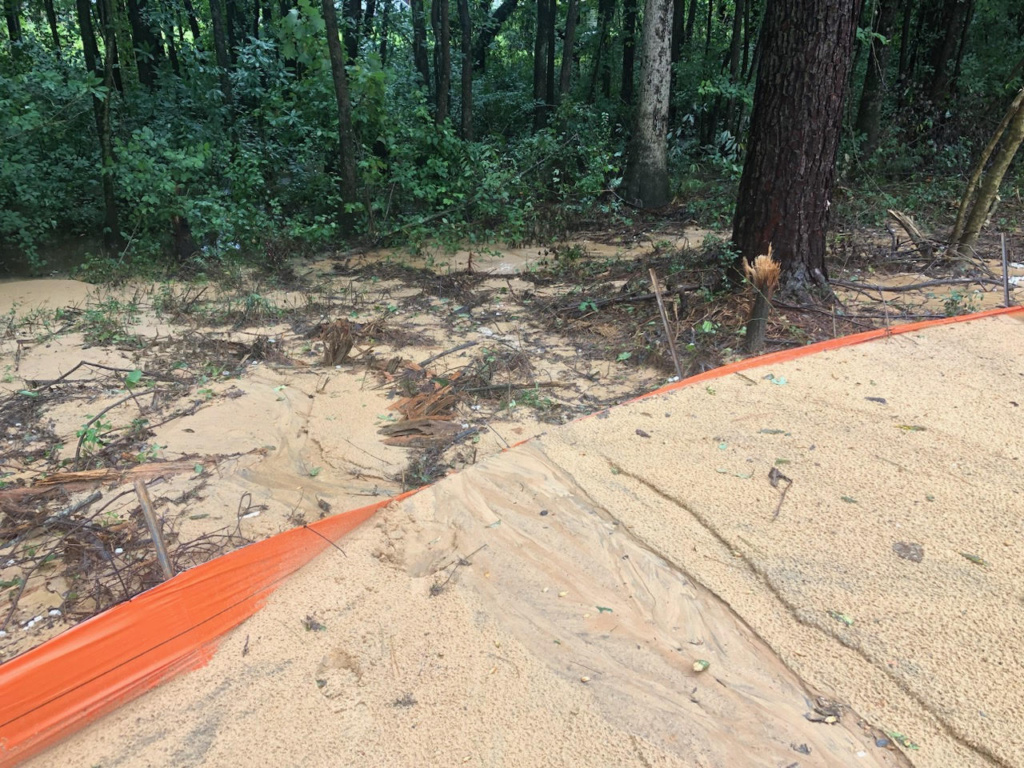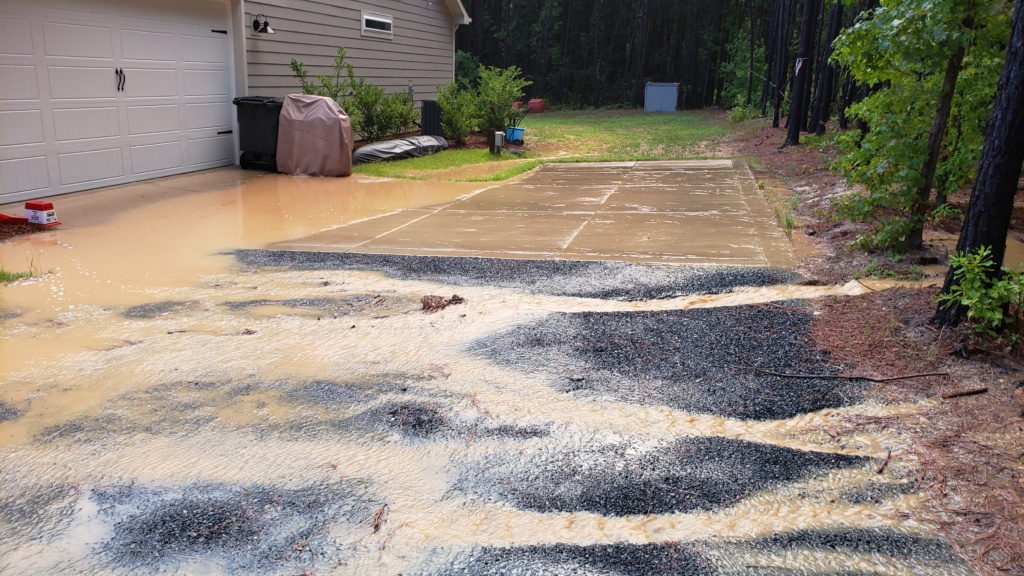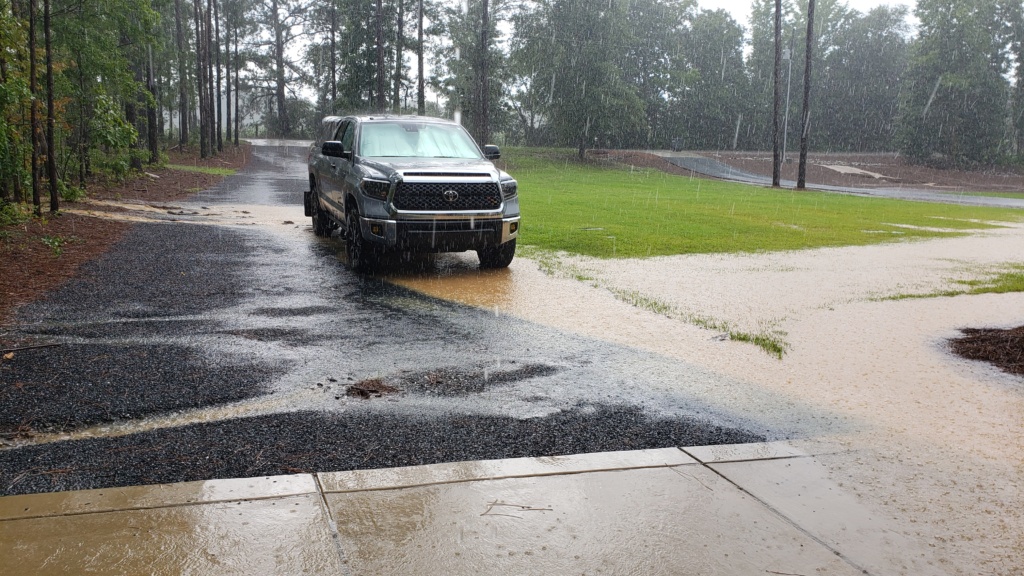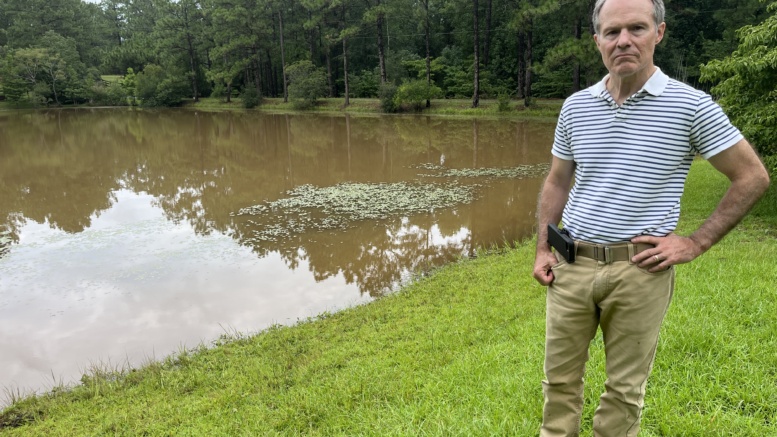By ANA RISANO and ELENA MARSH
Staff Writers
On the humid morning of Aug. 5, Steve Wilkins stepped onto his front porch to take in the view of his wooded yard and 3-acre pond. The water, normally clear or blue-green, was brown.
In the over 19 years he’s lived there, Wilkins said the pond had never been muddy — even with past hurricanes. He quickly found out it was the result of erosion from two upstream construction sites after a severe thunderstorm rocked Moore County the weekend of Aug. 3.
Across Moore County, residents are experiencing the impacts of infill and expansive developments changing the landscape. The results range from small annoyances to large-scale problems, especially when it comes to erosion and stormwater control.
Municipalities and Moore County officials are all struggling to find ways in which developers can do their jobs while also maintaining the property rights of those nearby.
“I’m already here,” Wilkins said. “That doesn’t give me any more rights than anybody else, but I at least ought to have the right where my property is protected.”
County Planning Director Debra Ensminger said her department receives a handful of complaints every month but doesn’t have much in the way of providing resources for people when they call.
“We do not have any language in our unified development ordinance that requires sedimentation control prior to the issuing of the zoning permit,” said Ensminger.
Erosion and sedimentation control is regulated by the state unless a town has a local program, which is the case for Southern Pines and Whispering Pines.
Proper permitting is required before construction, which then includes periodic inspections to ensure work conforms with the Sedimentation Pollution Control Act. These permits stay in effect until the work is completed.
Wilkins and his wife, Meg, own about 25 acres in Whispering Pines’ extraterritorial jurisdiction. Their pond is part of a larger water system, starting at Blue Lake and flowing through wetlands and ponds before entering Spring Valley Lake and moving on.
Wilkins identified the construction sites with visible erosion off Rothbury Drive. Developers are required to put in mitigation measures to prevent sediment from leaving a site. But on Aug. 5, the Monday after the weekend’s storms, Wilkins saw nothing.
Village Assistant Manager, Clerk and Zoning Administrator Linda Christopher said silt fencing was up the Friday before, having checked the property herself, but it was removed prior to landscaping work scheduled for Saturday.
That work didn’t happen, and the fencing wasn’t restored before the storm.
When Chirstopher was made aware of the issue, she called the contractors, and neon orange silt fencing was strung up. That fencing was still up on Aug. 9 when workers were cleaning up the site after Tropical Storm Debby blew through that week.
But the land still showed signs of channelized water flow, with sediment slowly moving into the muddied wetlands at the edge of the property. On Aug. 5, Wilkins said the channels were worse, sharing that the home farther up the hill had a roughly foot-deep trench caused by the rain.

Whispering Pines enforces a soil and erosion plan for developable properties under 1 acre. Anything larger requires state permits. Christopher said any submitted construction plans require mitigation measures, like having silt fencing in areas with lower elevations.
When an issue arises, she said the village first requires the developer to mitigate the issue within 10 to 14 days. If mitigation does not happen, the village then gives a notice of violation, where the developer has another 10 to 14 days to correct the problem or incur a fine.
“And I know when something’s happening to your personal property, it’s horrible, it needs to be addressed immediately, yesterday, it can’t wait, but there is a legal process we have to follow, and we do follow it,” she said.
But the process is a little different for Wilkins’ pond. The state Department of Environmental Quality advised that the water levels need to return to normal before removal activities occur.
Josh Kastrinsky, deputy communications director with the state DEQ, said staff from multiple divisions at the regional Fayetteville office visited Wilkins’ property in early August, taking note of the erosion issues that happened before and after Tropical Storm Debby.
He said the construction team was asked to add more mitigation measures and correct existing ones. For remedying the sediment issue, the team advised the builders would need to remove the sediment manually, meaning with a bucket and shovel, not machines, once the area dries out.
While Wilkins has experienced an erosion issue personally, he emphasized it seems to be a greater problem in Moore County.
“This is a much bigger problem,” he said. “This is just one example, I think, of a much bigger problem that’s going on around here. Our local officials are falling behind.”
County Responds
County Commissioner Jim Von Canon agrees. He has been an outspoken champion of property rights in this discussion across the county.
“We need something in our ordinance. … We need something with some bite. It’s not to punish (the builders), but we also don’t want our homeowners to be punished.”
In a recent special meeting of the Board of Commissioners, the county discussed a property all too familiar to the issues Wilkins faced.
Josiah Swim and his wife, Sarah, have lived on their property for two years, having moved into their home on Niagara-Carthage Road in 2022. In March of this year, they started to see a flooding problem due to a neighboring builder, but it wasn’t catastrophic.
On Valentine’s Day, after all of the trees were cleared and the spring rainstorms picked up, the Swims noticed significant flooding across their property. All it takes now is 1 inch to 1 1/2 inches of rainfall to cause deep trenches in the gravel driveway and pooling at their garage door.
The large pools of water that run up to the Swims’ home and down to a neighboring property take about six to 12 hours to dry. Sediment is often left behind, ruining the grass and landscaping.
The Swims have been in contact with the builder and have received varied responses to the problem, depending on the person. A few mitigation factors were added when the couple reached out, but the erosion continues despite the silt fences.

“Despite sporadic attempts from the builder to stop the flooding from breaching our boundary, it has not been totally effective to date, and we have had six separate major silt-flood erosion events stretching hundreds of feet, damaging our property,” said Josiah Swim in a statement. “It also threatens to flood our septic holding tank, and if breached, contaminate the local watershed as the runoff runs into the stream behind our house.”

In their experience, the Swims have found that there is very little in terms of regulation that protects a homeowner.
“We’ve been educated to the fact that there is very little to protect the individual taxpayer from building activity,” said Josiah Swim.
Similar to Whispering Pines, DEQ receives complaints about properties and requires corrective actions. If an issue is not addressed, the site may be given a notice of violation, Kastrinsky said.
“In our experience engaging with regulators, North Carolina DEQ and Moore County are caught in a ‘doom loop’ of outdated and ineffective environmental regulations that ultimately doesn’t protect county taxpayers like ourselves from small development mismanagement and cost-cutting construction practices,” said Swim.
But there may be an answer.
Marsh Smith, an attorney who grew up in Southern Pines, has approached county commissioners with a resolution supporting restoration of the Sedimentation Pollution Control Act at the state level. That would allow citizens harmed by violations to file a suit.
“In the last approximately two months,” said Smith in an email to the county commissioners, “I have been contacted by half a dozen people damaged by out-of-control sedimentation from development. They can’t sue under the SPCA to protect themselves and their property.”
The reason why? Property owners would need a notice of violation from an enforcement authority, such as DEQ, something Smith said is “nearly impossible” to receive.
Annually, DEQ’s Fayetteville office receives about 100 erosion-related complaints substantiated by an investigation. Kastrinsky said a lot of those complaints are tied to impacts from precipitation.
In any given year, DEQ oversees about 3,000 active projects with erosion and sedimentation control plans, which involve a fair amount of work from approving plans and regular compliance inspections.
Staff at the Fayetteville office estimate receiving about 50 to 80 new erosion and sediment control plans for review per month.
Kastrinsky said the organization has seen an increase in projects in recent years, noting North Carolina is growing fast.
“We are seeing a growth in construction projects coming through the programs at DEQ,” Kastrinksy said.
At a special meeting of the Moore County Board of Commissioners on Aug. 22, Chairman Nick Picerno called for the resolution to be placed on the next agenda for consideration for a vote. If passed, the resolution would go to the legislature for consideration.
“Isn’t it time,” Smith said, “for the Moore County Board of Commissioners to take action to allow landowners to defend themselves against brazen violations of the SPCA by builders and developers?”
Contact Ana Risano at (910) 585-6396 or ana@thepilot.com. Contact Elena Marsh at (910) 693-2484 or elena@thepilot.com.







